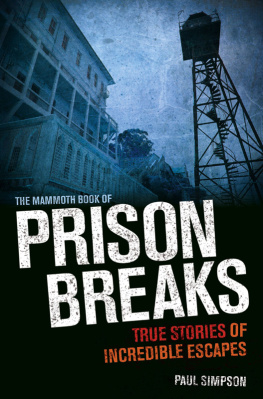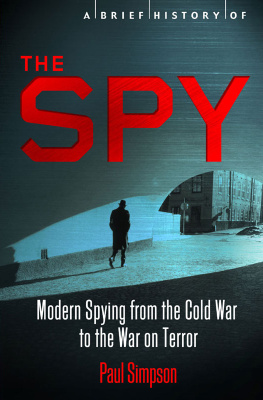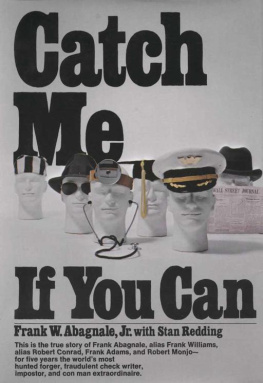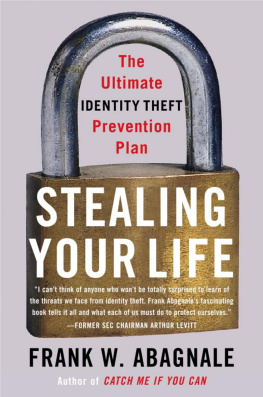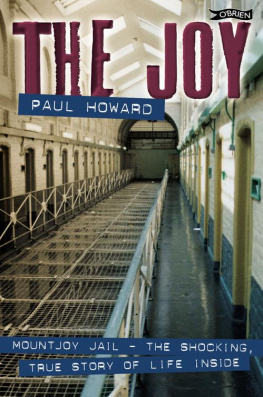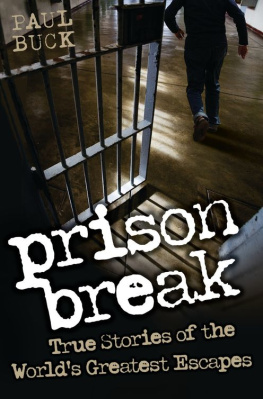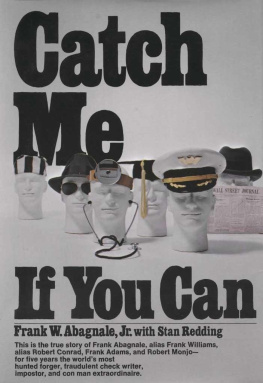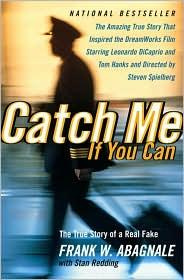Paul Simpson - The Mammoth Book of Prison Breaks
Here you can read online Paul Simpson - The Mammoth Book of Prison Breaks full text of the book (entire story) in english for free. Download pdf and epub, get meaning, cover and reviews about this ebook. year: 2013, publisher: Running Press, genre: Detective and thriller. Description of the work, (preface) as well as reviews are available. Best literature library LitArk.com created for fans of good reading and offers a wide selection of genres:
Romance novel
Science fiction
Adventure
Detective
Science
History
Home and family
Prose
Art
Politics
Computer
Non-fiction
Religion
Business
Children
Humor
Choose a favorite category and find really read worthwhile books. Enjoy immersion in the world of imagination, feel the emotions of the characters or learn something new for yourself, make an fascinating discovery.
- Book:The Mammoth Book of Prison Breaks
- Author:
- Publisher:Running Press
- Genre:
- Year:2013
- Rating:4 / 5
- Favourites:Add to favourites
- Your mark:
- 80
- 1
- 2
- 3
- 4
- 5
The Mammoth Book of Prison Breaks: summary, description and annotation
We offer to read an annotation, description, summary or preface (depends on what the author of the book "The Mammoth Book of Prison Breaks" wrote himself). If you haven't found the necessary information about the book — write in the comments, we will try to find it.
The Mammoth Book of Prison Breaks — read online for free the complete book (whole text) full work
Below is the text of the book, divided by pages. System saving the place of the last page read, allows you to conveniently read the book "The Mammoth Book of Prison Breaks" online for free, without having to search again every time where you left off. Put a bookmark, and you can go to the page where you finished reading at any time.
Font size:
Interval:
Bookmark:
A spot-check of Google News on 28 November 2012 reveals that in New Orleans the day before, a trio of prisoners were recaptured after injuring themselves on razor-wire during their flight. Dozens of prisoners escaped from Tete Provincial Prison in Mozambique on Sunday 25 November, after sabotaging the electricity supply and plunging the compound into darkness. Three inmates went on the run from Kamfinsa prison in Zambia the same day. A week earlier in India, four remand prisoners stabbed a warder, scaled the Kochi prison wall and escaped. Around the same time, in Jackson County, Oregon, a convicted bank robber was able to stand on another prisoners shoulders, remove some metal mesh from a roof covering, and jump into a nearby tree. The trees have been cut down; despite a $6,000 reward there is no sign yet of Bradley William Monical...
Even if prisons are built like the ones that John Carpenter envisaged in his movies Escape from New York and Escape from L.A. (where Manhattan Island and Los Angeles respectively are turned into federal penitentiaries), the men and women incarcerated there will try to escape. As Emmanuel Goldstein said, The primary obligation of any prisoner is to escape.
If someone is determined to escape, it will be difficult to prevent him from doing so without making life virtually impossible for all concerned. There is room for a great deal of research and thought into the main factors which make people want to escape. In many cases a prisoner will make a cold and rational estimate of the position and will then decide whether or not it is worth taking the risk. Perhaps, in that sort of case, we must accept that one needs to watch him like a lynx. If a man is given such a long sentence and in such conditions that he has nothing to hope for, one cannot be surprised if he breaks out.
The second category is comprised of those to whom the possibility of escape presents a challenge. Anyone who has read The Prisoner of Zenda or even Huckleberry Finn will know the feeling that exists in all of us, particularly when reading about these matters or when reading stories about escapes from prisoner-of-war camps. I believe that these feelings are sometimes projected into escapes from Her Majestys Prisons. With the right kind of prisoner, one possible way of dealing with the problem would be to remove the challenge by offering him open conditions. Any challenge having been removed, there are certain types of prisoner who would no longer be impelled to escape.
The third group comprises two categories of men. There is the man with a genuine or imaginary beef, because he is really innocent or because of something which has happened inside the prison. The other category is the man with a personal problem, possibly to whom some kind friend has indicated that his wife is carrying on with a neighbour. Unless he can be satisfied in some way, he will be impelled to break out.
Then there is the man who is unable to resist temptation, and who, if he sees the hole to which my hon. Friend the Member for Liverpool, Walton (Mr. Heller) referred, cannot resist walking through it. In that case, clearly the only satisfactory safeguard is to make sure that there are no holes of that kind left accidentally.
Peter Archer, MP for Rowley Regis and Tipton, 16 February 1967, in the House of Commons debate following the escape of George Blake from Wandsworth Prison, and the Great Train Robbers. Extracted from Hansard
My grateful thanks to the many people who suggested stories for this book, and especially all those who checked out the histories of their part of the world for me to provide some of the more obscure tales contained in these pages: Brian J. Robb, Andy Frankham-Allen, Adina Mihaela Roman, and Patricia Hyatt.
My thanks also to:
Duncan Proudfoot for commissioning this in the first place, and for helping to ease the burden a little to allow real life to continue; and my copyeditor Gabriella Nemeth, who once again saved me from some idiocies of my own making.
Revd Clay Knowles for background information on St John of the Cross escape.
Michael, our guide in Berlin at Easter 2012, who showed us round the route of the Wall, and shared stories about the escapes, many of which feature in this book.
Brian J. Robb again for wading through the material and providing some pithy comments which helped to focus the book.
The staff of The Laptop Workshop in Burgess Hill and Haywards Heath ( http://www.laptopworkshop.com/ ) who were able to get me back up and running within 36 hours. (And to the maintainers of Dropbox for the secure facility that made sure nothing was lost!)
The librarians at the Hassocks branch of the West Sussex Public Library. I say this in every book, but it continues to be key: great as the internet is, it will never replace libraries, and I am grateful to the team for their help in tracking down some of the more obscure books needed for this volume.
Lee Harris, Amanda Rutter, Caitlin Fultz, Scott Pearson, and Clare Hey for providing other avenues while this was ongoing, and to the members of ASCAT church choir, All the Right Notes choir, and the Hurst Singers for the musical outlets.
Finally, and most importantly, my partner Barbara and daughter Sophie for their love and support, and for letting me disappear into the office to get this completed and our terriers, Rani and Rodo, who have finally got the message about the correlation between desk, computer and staying quiet!
Prisoners particularly those who feel that they have nothing left to lose, such as those serving life sentences will take advantage of any chink that they find in the security of the establishment in which they are being held. It usually doesnt matter to them whether the escape happens tomorrow, next week or next year, just so long as they can finally get away over, through, or under the walls that are keeping them away from the life they want to lead.
Political prisoners often regard themselves as prisoners-of-war with the same concomitant duty to escape, and during the years of the struggle in Northern Ireland, those who were held by the British considered it an absolute imperative to get free in order to continue the fight. Equally, those holding them were resolutely trying to ensure that they didnt have that opportunity.
When the Maze prison was designed, with its many high-security features, no one would have guessed that the weak point would be a lorry that carried food and other items around the camp. But on 25 September 1983, thirty-eight highly dangerous members of the Irish Republican Army used that lorry to break out and had it not been for a slight delay in its schedule for the day, they would probably have been able to drive out through the gates. As it was, it got them as far as the airlock before the final gate, from where they were able to escape mostly over the fence.
The Maze prison had grown into a huge maximum-security prison on the site of the Long Kesh internment camp, a set of Nissen huts on a disused RAF airfield about nine miles southwest of Belfast in Northern Ireland. The British governments reaction to the problems with holding IRA prisoners following the introduction of interment in 1971 had been the creation of eight H-Blocks, which were designed as the ultimate in prisoner control. Named after their shape of a capital H, each leg of the H was a wing, a self-contained prison unit, with the bar of the H forming the circle, the nerve centre of the unit. Prisoners were not meant to be able to move between wings except under guard, and there were barriers between the wings and the circle to prevent movement. Within the circle were the areas for the prison guards, as well as the Emergency Control Room (ECR) which housed the alarms, a telephone and a radio.
Font size:
Interval:
Bookmark:
Similar books «The Mammoth Book of Prison Breaks»
Look at similar books to The Mammoth Book of Prison Breaks. We have selected literature similar in name and meaning in the hope of providing readers with more options to find new, interesting, not yet read works.
Discussion, reviews of the book The Mammoth Book of Prison Breaks and just readers' own opinions. Leave your comments, write what you think about the work, its meaning or the main characters. Specify what exactly you liked and what you didn't like, and why you think so.

